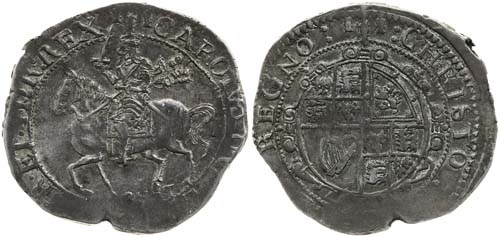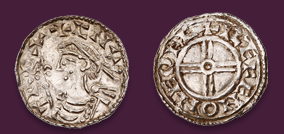
Auction: 5033 - The Colin Adams Collection of Halfcrowns
Lot: 242
Charles I, Chester mint (1644), Halfcrown, 14.63g., king in armour holding sword upright, riding left on spirited horse with full chest and wavy tail, CHST below, plume behind, CAROLVS D G MAG BRI FR ET HIR REX (sic), rev. oval garnished shield, CHRISTO AVSPICE REGNO, pellet/double pellet stops, m.m. sword erect between three gerbs (JGB 1111 (same dies); Lyall B/2; N.2627; S.3130) struck on an irregular flan, weak on parts of legend, with light cabinet wear on reverse, otherwise an unusually fine example, deeply toned, almost extremely fine, very rare thus Estimate £ 2,500-3,000PROVENANCE: H Corke, Sotheby, 15 April 1848, lot 30 E W Rashleigh, Sotheby, 21 June 1909, lot 929 Dr E Burstal, Glendining, 15 May 1968, lot 384 P Hunt, portion of collection purchased privately by Colin Adams, March 2000 A month after King Charles raised his standard at Nottingham, on 22 August 1642, he visited Chester. The parliamentary sympathisers departed and the Royalists set about fortifying the city. In December 1644 Chester was besieged. The siege eased somewhat during the summer of 1645, but in the autumn the city was heavily bombarded, and it finally surrendered to terms on 3 February 1645/6. In the Assembly Book for 31 January 1644/5 there is an entry ´That as much of the ancient plate of this citty as will amount to ye summe of one hundred poundes shall be fourthwith converted into coyne for the necessarie use and defence of this citty and towards the payment of the citty´s debts´. The need for ready money can be judged from the cost of food and pay for the 7,100 Parliamentary troops besieging Chester, £72,826 12s. for sixteen weeks, or more than £4,500 per week, Lyall, SNC 1971, p.98. The mintmark on this coin clearly derives from the old city arms of Chester, which were three gerbs surmounted by a sword of state in pale. When in the last quarter of the seventeenth century a system of hall marking was introduced for silver made in Chester, these arms were adopted as the town mark, BNJ 1982, p.244.
Sold for
£3,000




